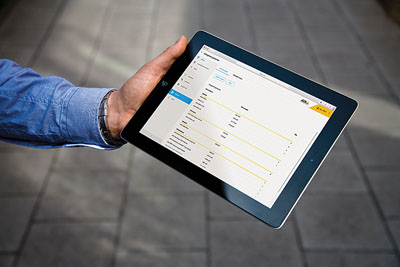One significant change to the way businesses and organisations invest in technology has been the growth of service-based offerings. Nowhere is this more obvious than in IT. Where once companies invested heavily in hardware and software (often with a team to manage the system), today many businesses opt for software-as-a-service (SaaS). This is where software is either accessed via a cloud connection, or local installations use remote resources. End users like this model, so it makes sense to consider it for smart security systems too.
In the past, businesses took an approach to IT provision which, today, seems a little archaic. Companies would invest in servers and processing power to run complex programs and manage huge amounts of data. They would then purchase software required for management tasks, and this would usually be supplied on physical installation disks or other media.
An in-house IT team would then spend time installing, configuring and licensing the various applications, which also resulted in downtime for the company as installations could be slow and complicated. This would be further compounded by the fact that every PC or workstation would need to have the software installed.
The IT team would then need to manage the hardware and software, implementing updates and ensuring sufficient resources were available for processing and storage of data. Often separate hardware and software would be required for data storage, process control and other business tasks.
In today’s technological landscape, this all sounds a bit too labour-intensive and cumbersome, but at the time the benefits available from IT were significant. It was the price businesses and organisations paid for the advantages of increased efficiency.
In today’s commercial and industrial sectors, as well as across the consumer market, the entire approach to IT provision has changed. Given the huge uptake in the new approach by businesses and organisations, even the cynical amongst us must admit the more service-biased approach is growing in popularity.
Increased flexibility, added convenience and controllable costs have made software-as-a-service (SaaS) the ‘go to’ way of delivering IT functionality. While initial pushes for SaaS technology were driven by the big names in computing technology, even the more specialist companies are moving to a SaaS approach. The drivers are simple: customers like SaaS because it offers them a simple and stress-free approach for a regular and fixed subscription fee.
It’s fair to say that the purchase of software, coupled with self-installation and configuration, using in-house resources, is now the unusual approach. The important issue is that end users expect SaaS, and when they’re offered something which lacks the positives of service-based provision, it is one more barrier which must be overcome. Customers will actually turn away from solutions which aren’t offering a service.
Security concerns
It is vital to understand that while SaaS (and the VSaaS – video surveillance as a service – and ACaaS – access control as a service – derivations) is relatively new to the security market, this approach is very well established in other sectors. That means the security industry is effectively trying to catch up with other industries.
 That said, a number of the innovative companies within the security market have been working towards the delivery of a proven, stable and effective SaaS portfolio for many years, and now it is not only possible to provide an end-to-end service-based solution, but legacy systems can be supplemented with SaaS elements to provide credible and flexible solutions. Whether taking a hybrid or a pure SaaS solution, for many integrators the next step is to meet user demands and design systems which deliver all of the plus points which customers have come to understand and appreciate within SaaS solutions.
That said, a number of the innovative companies within the security market have been working towards the delivery of a proven, stable and effective SaaS portfolio for many years, and now it is not only possible to provide an end-to-end service-based solution, but legacy systems can be supplemented with SaaS elements to provide credible and flexible solutions. Whether taking a hybrid or a pure SaaS solution, for many integrators the next step is to meet user demands and design systems which deliver all of the plus points which customers have come to understand and appreciate within SaaS solutions.
In the past, many in the security sector had concerns about reliance on a cloud platform. The network load from security solutions was high and even short outages could not be accepted. Fears that a cloud problem might compromise security made many integrators skirt around the technology, instead sticking with localised hardware and software provision.
Today’s cloud services are varied, and encompass everything from serverless solutions were all processing, storage and management happens off-site, through to more bespoke applications where critical video is archived securely, but the cloud is used for a number of additional services such as reporting, system management, metadata filtering and even system design.
As with dedicated hardware and software, SaaS can be deployed in a variety of ways, ensuring the right balance of security and flexibility is achieved. End users can realise add-on benefits which enhance their day-to-day business, without any concerns or risks to the security of their site.
For example, a retail site might make use of Axis video cameras for security and site management. Video can be archived at the edge, eliminating a need for servers or NVRs. When incidents occur, the retailer can view video through a cloud interface from any location with a network connection. This makes monitoring a site and assessing incidents simple and fast for the customer, while also being cost-effective.
If the cameras make use of on-board applications, they can also provide important business intelligence data, such as queue management information or people counting data. With many security systems, it will be necessary for a marketing manager, for example, to access the camera’s webpages to view this business data. However, through a cloud connection, they can view only the data which they’re authorised to see, and cannot interfere with the system or the camera configurations.
Indeed, they have no need to interact with the system at all, as the data can be viewed on mobile devices through viewing apps, or on any PC via a standard browser. The data is available to them around the clock, without any risk to the security infrastructure, and the need for dedicated software is eliminated. This frees up their IT resources for more important tasks.
 Other benefits of SaaS include an enhanced approach to cybersecurity. One issue is that firmware updates and software patches need to be regularly applied to stay ahead of evolving threats. In a traditional IT setting, this means that every workstation needs to have patches applied in order to ensure secure and stable systems. Because SaaS is effectively a single software entity which is connected to by all users at a site, a single upgrade – carried out by the service provider – ensures the system remains table, and all users are always working on the latest version software. For the integrator, this reduces their workload.
Other benefits of SaaS include an enhanced approach to cybersecurity. One issue is that firmware updates and software patches need to be regularly applied to stay ahead of evolving threats. In a traditional IT setting, this means that every workstation needs to have patches applied in order to ensure secure and stable systems. Because SaaS is effectively a single software entity which is connected to by all users at a site, a single upgrade – carried out by the service provider – ensures the system remains table, and all users are always working on the latest version software. For the integrator, this reduces their workload.
SaaS-based systems are easier to sell, because end users understand the benefits. For the integrator, they’re also easier to install and configure. Many of the problematic issues with network-based solutions such as port forwarding are eliminated. Security is also enhanced as the authentication procedures are handled by the service provider.
When it comes to costs, end users again benefit, as do integrators. As Axis provides a subscription-based surveillance service, users can reduce their initial investment, and are also reassured the solution will not become obsolete. Because the software and processing resources are hosted in the cloud, sites can easily upgrade their system with new features, applications and services.
There is also a benefit in terms of hardware. With the more localised approach to system design, often servers and other IT hardware needs to be budgeted for, with costs for purchase, installation and maintenance. Because Axis SaaS solutions are designed to use open IP standards, they can be connected with any existing IT equipment. The SaaS solutions are flexible, scalable, and will work out of the box with legacy network infrastructure, routers, monitors, computers, tablets and smartphones.
For the integrator, the SaaS model delivers a recurring revenue stream, ensuring maintenance remains an integral part of the system delivery. There are also benefits to reduce time on site, with effective tools which support the design and configuration of Axis solutions.
In summary
The security industry must address the demands of end users, and SaaS is a preferred business approach for many businesses and organisations. As IoT implementations increase, so the service element will become more important, and integrators who don’t embrace the technology could find themselves missing out on contracts.
For the end user, SaaS offers greater flexibility and scalability, advanced functionality and added business benefits, while also delivering a cost-effective subscription model which better suits business budgeting.
For the integrator, SaaS allows the delivery of a bespoke solution which is simpler to specify and install, includes a recurring revenue stream, and includes features to make configurations more intuitive.
SaaS represents the future, and Axis is committed to delivering the right solutions.







